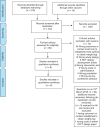A systematic review of tailored eHealth interventions for weight loss
- PMID: 30783535
- PMCID: PMC6366004
- DOI: 10.1177/2055207619826685
A systematic review of tailored eHealth interventions for weight loss
Abstract
Objective: The aim of this study is to review the evidence for tailored eHealth weight-loss interventions, describing in detail: 1. how tailoring was implemented in these studies and 2. whether these tailored approaches were effective in producing weight loss compared with generic or inactive controls.
Methods: A systematic review was carried out. Five databases were searched up until 15 March, 2018, including: EBSCO, Science Direct, Pubmed, EMBASE and Web of Science, using combinations of the concepts 'tailoring', 'eHealth' and 'overweight'.
Results: Eight articles relating to six interventions were accepted. Tailoring was carried out in a number of ways, based on, for example, anthropometric data, health-related behaviours (e.g. dietary intake, physical activity), goals (e.g. weight goal), theoretical determinants (e.g. confidence/willingness to change behaviours), psychosocial factors (e.g. social support) and participant location. Systems acquired data using strategies that ranged from online questionnaire administration, to the dynamic gathering of data from web-based diaries, websites, mobile applications and SMS messaging. Tailored interventions were more effective in supporting weight loss than generic or waitlist controls in four of the six articles. Effect sizes were very small to moderate, with evidence for fluctuations in effect sizes and differences of effect between tailoring and non-tailoring interventions, and between tailoring types, over time.
Conclusions: We contribute an enhanced understanding of the variety of methods used for the tailoring of eHealth interventions for weight loss and propose a model for categorising tailoring approaches.
Keywords: Tailoring; eHealth; engagement; health behaviour change; obesity; personalisation; systematic review; weight loss.
Figures
Similar articles
-
Weight Management in Young Adults: Systematic Review of Electronic Health Intervention Components and Outcomes.J Med Internet Res. 2019 Feb 6;21(2):e10265. doi: 10.2196/10265. J Med Internet Res. 2019. PMID: 30724736 Free PMC article.
-
The effect of weight management interventions that include a diet component on weight-related outcomes in pregnant and postpartum women: a systematic review protocol.JBI Database System Rev Implement Rep. 2015 Jan;13(1):88-98. doi: 10.11124/jbisrir-2015-1812. JBI Database System Rev Implement Rep. 2015. PMID: 26447010
-
The effectiveness of web-based programs on the reduction of childhood obesity in school-aged children: A systematic review.JBI Libr Syst Rev. 2012;10(42 Suppl):1-14. doi: 10.11124/jbisrir-2012-248. JBI Libr Syst Rev. 2012. PMID: 27820152
-
Identifying Persuasive Design Principles and Behavior Change Techniques Supporting End User Values and Needs in eHealth Interventions for Long-Term Weight Loss Maintenance: Qualitative Study.J Med Internet Res. 2020 Nov 30;22(11):e22598. doi: 10.2196/22598. J Med Internet Res. 2020. PMID: 33252347 Free PMC article.
-
Current Evidence and Directions for Future Research in eHealth Physical Activity Interventions for Adults Affected by Cancer: Systematic Review.JMIR Cancer. 2021 Sep 20;7(3):e28852. doi: 10.2196/28852. JMIR Cancer. 2021. PMID: 34542415 Free PMC article. Review.
Cited by
-
Application and effectiveness of eHealth strategies for metabolic and bariatric surgery patients: A systematic review.Digit Health. 2020 Jan 7;6:2055207619898987. doi: 10.1177/2055207619898987. eCollection 2020 Jan-Dec. Digit Health. 2020. PMID: 32030193 Free PMC article. Review.
-
Automated Messaging Delivered Alongside Behavioral Treatment for Weight Loss: Qualitative Study.JMIR Form Res. 2023 Nov 6;7:e50872. doi: 10.2196/50872. JMIR Form Res. 2023. PMID: 37930786 Free PMC article.
-
Efficacy of eHealth interventions to reduce depression symptoms in individuals with obesity: a systematic review of randomized controlled trials.Front Psychiatry. 2024 Mar 7;15:1296433. doi: 10.3389/fpsyt.2024.1296433. eCollection 2024. Front Psychiatry. 2024. PMID: 38516265 Free PMC article.
-
Sustainability of Weight Loss Through Smartphone Apps: Systematic Review and Meta-analysis on Anthropometric, Metabolic, and Dietary Outcomes.J Med Internet Res. 2022 Sep 21;24(9):e40141. doi: 10.2196/40141. J Med Internet Res. 2022. PMID: 36129739 Free PMC article.
-
Virtually delivered lifestyle interventions for overweight and obese pregnant people: A systematic review.Womens Health (Lond). 2025 Jan-Dec;21:17455057251336292. doi: 10.1177/17455057251336292. Epub 2025 May 19. Womens Health (Lond). 2025. PMID: 40388534 Free PMC article.
References
-
- Hutchesson MJ, Rollo ME, Krukowski R, et al. eHealth interventions for the prevention and treatment of overweight and obesity in adults: a systematic review with meta-analysis. Obes Rev 2015; 16: 376–392. - PubMed
LinkOut - more resources
Full Text Sources
Medical




